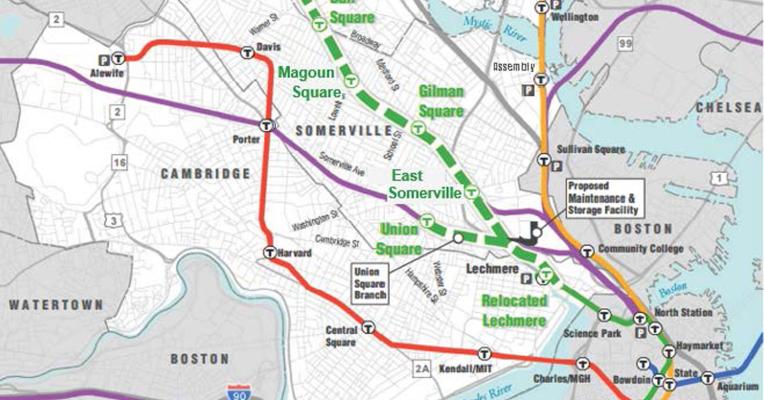F-Line to Dudley
Senior Member
- Joined
- Nov 2, 2010
- Messages
- 9,561
- Reaction score
- 10,466
Could we someday reconfigure the Tufts/Medford station to have commuter rail / regional rail tracks as the outer tracks, Green Line as the inner tracks, and one island platform with the northbound Green Line (discharge only) on the inside and northbound commuter rail on the outside, and the other island platform with southbound Green Line on the inside and southbound commuter rail on the outside, to enable cross platform transfers from one mode to the other for passengers continuing in the same direction?
That would require building a flyover somewhere between that station and Ball Sq for the inbound commuter rail track to trade places with the Green Line tracks. At Tufts/Medford, the Green Line railheads would presumably be a few feet higher than the commuter rail railheads to get level boarding for both modes with cross platform transfers.
It looks like the ROW is only tangent for roughly 600' railroad north of College Ave before curving, so for 800' platforms, roughly 200' of platforms would need to be built south of College Ave, and the portion of the platforms south of College Ave might need to be built to be as narrow as possible.
An alternative might be to build the northbound platform for both modes at the same elevation as the current tracks, and build the southbound platform for both modes underneath that (or vice versa); that would eliminate the need to have one mode fly over the other.
If we extend the Orange Line to Reading, and give Haverhill via Wildcat 15 minute headways to Boston, plus give Lowell trains 15 minute headways to Boston, that should provide 7.5 minute headways on the Wilmington to Boston segment.
If commuter rail upgrades to trains that can accelerate at 2.5 MPH/s, could we reasonably have all Haverhill Line via Wildcat and Lowell Line trains make stops at both Tufts/Medford and where a Route 16 Green Line station has been proposed, making Route 16 a commuter rail stop instead of a Green Line stop (building platforms next to the existing tracks is probably a lot less costly than rebuilding bridges to support quad tracking)?
Why would we ever want to do that? CR options were studied during the MIS scoping eons ago, and the corridor characteristics showed absolute bupkis demand for an outer transfer. GLX isn't the slightest like Malden, Quincy Ctr., or Ruggles with their gigantic bus hubs or Porter with with the 1-stop proximity to a gigantic bus hub. Those are the only drivers for CR/rapid transit superstations on the system, and this corridor doesn't have a plausible candidate. It's primarily intra-Somerville and Somerville-CBD transit, with Tufts not being a commuter school and not being nearly the magnet for independent employer variety that the other big schools are. Ridership would absolutely blow for all the messiness construction would entail, and it would slow down Lowell/Haverhill too much to add too-far underutilized infill stops.
The NH Main arguably needs to reshuffle its deck of inner stops, because West Medford's patronage is going to crater and move to Route 16 down the street, with bus optimizations making frequencies to the 6-min. rapid transit transfer always more frequent than a :15 RUR turn. The siphon to Green is going to be too overwhelming for increased CR service to recoup the losses; West Med is firmly in the category of 'migratory' catchment once Route 16 opens. Wedgemere is a problem because it dilutes too-close Winchester Ctr.'s ridership and can't easily be raised to level boarding with a gauntlet track because of the curve. If the post-GLX bus revamp institutes a Davis-Winchester bus route via the 94's Boston Ave. routing that diverges up Playstead Rd. from West Med to Winch Ctr., it'll drag a lot of Wedgemere patronage to GLX-Route 16 or tied in a bow @ Winchester instead. In the end it'll be easier for Haverhill trains to skip West Med + Wedgemere altogether and start picking up the local stops at Winchester for the sake of keeping its end-to-end schedule at an hour, leaving just the :30 Lowell turns at West Med and maybe an excuse to abolish un-upgradeable Wedgemere altogether.
Inside-128 infills for RUR are being considered where the ridership duly slays...places like Salem State U., Newton Corner, Quannapowitt/128, Weston/128, enormous Sullivan Sq. bus hub (see point above re: Malden, QC, Ruggles, etc.), and West Station if the Beacon Park moonscape gets properly developed in our lifetimes. The consensus picks. RUR isn't some free-for-all where it's open season to spray new stops around like confetti for the hell of it where magic pixie dust will make a candidate that previously had no bona fides going for it suddenly contribute buff ridership. The ones that start out strong at CR frequencies stay strong at RUR frequencies; the ones that have fatal problems attracting flies at CR frequencies tend to have more widespread problems holding them back than just the underwhelming frequencies, or else they wouldn't look so squishy in the first place. Sites that have previously studied out with ass ridership--Wonderland, the co-GLX's, Alewife, etc.--are still going to study out with total garbage fundamentals because the sitings and transfer assumptions were flawed as hell to begin with and higher RUR service levels doesn't suddenly make flawed sitings un-flawed. No matter how much some advocates keep pushing those zombie repeats one more time as a political pet.
Last edited:










 IMG_3577
IMG_3577 IMG_3579
IMG_3579 IMG_3583
IMG_3583 IMG_3588
IMG_3588